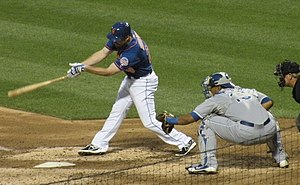
Catcher is a position in baseball and softball. When a batter takes their turn to hit, the catcher crouches behind home plate, in front of the (home) umpire, and receives the ball from the pitcher. In addition to this primary duty, the catcher is also called upon to master many other skills in order to field the position well. The role of the catcher is similar to that of the wicket-keeper in cricket.
Positioned behind home plate and facing toward the outfield, the catcher can see the whole field, and is therefore in the best position to direct and lead the other players in a defensive play. The catcher typically calls for pitches using PitchCom, or hand signals. The calls are based on the pitcher's mechanics and strengths, as well as the batter's tendencies and weaknesses. Essentially, the catcher controls what happens during the game when the ball is not "in play". Foul tips, bouncing balls in the dirt, and contact with runners during plays at the plate are all events to be handled by the catcher, necessitating the use of protective equipment. This includes a mask, chest and throat protectors, shin guards, and a heavily padded catcher's mitt. Though rare, some chest protectors may extend lower to provide some shield to the genitalia; wearing a pelvic protector or cup, depending on the case, is preferred and more common.
Because the position requires a comprehensive understanding of the game's strategies, the pool of former catchers yields a disproportionate number of managers in both Major League Baseball and Minor League Baseball, including such prominent examples as Yogi Berra, Connie Mack, Steve O'Neill, Al López, Mike Scioscia, Joe Girardi, Stephen Vogt, and Joe Torre.[1] The physical and mental demands of being involved on every defensive play can wear catchers down over a long season, and can have a negative effect on their offensive output. As a result, catcher is the only position (other than pitcher) to not have a member of the 3,000 hit club[2] (not counting Craig Biggio, who only played four seasons as a catcher and was a second baseman when he reached the milestone); the current hit leader for the position is Iván Rodríguez, with 2,844.[3]
Because of the strategic defensive importance of catching, if a catcher has exceptional defensive skills, teams are often willing to overlook their relative offensive weaknesses.[2] A knowledgeable catcher's ability to work with the pitcher, via pitch selection and location, can diminish the effectiveness of the opposing team's offense.[4] Many great defensive catchers toiled in relative anonymity, because they did not produce large offensive numbers. Notable examples of light-hitting, defensive specialists were Jerry Grote, Jeff Mathis, Martín Maldonado, Ray Schalk, Jim Hegan, Jim Sundberg and Brad Ausmus. Schalk's career batting average of .253 is the lowest of any position player in the Baseball Hall of Fame.[5] His selection for enshrinement in 1955 was largely a tribute to his outstanding defensive skills.[5]
In the numbering system used to record baseball plays, the catcher is assigned the number '2'. (See Baseball scorekeeping.)
- ^ Andriesen, David (November 2003). Catchers Are Baseball's Least Appreciated Players. Retrieved 9 March 2012.
{{cite book}}:|work=ignored (help) - ^ a b Doyle, Al (June 1997). Never Underestimate A Good Defensive Catcher. Retrieved 9 March 2012.
{{cite book}}:|work=ignored (help) - ^ "This is each position's all-time hit king". MLB.com.
- ^ Vass, George (May 2005). For Catchers, The Name of the Game is Defense. Retrieved 9 March 2012.
{{cite book}}:|work=ignored (help)[permanent dead link] - ^ a b "howstuffworks.com". Entertainment.howstuffworks.com. Retrieved 2013-09-21.